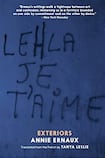
Exteriors, Fitzcarraldo’s latest translation from the oeuvre of Annie Ernaux, consists of a series of fragmented paragraphs depicting things seen in the world, all taken from diaries kept between 1985 and 1992.
In her explicatory introduction, Ernaux professes a desire to convey pure exteriority, although she acknowledges the inevitable influence of her own preoccupations upon the “random” selection of scenes. She likens the brief, loosely related descriptions to a series of photographs, and puts forth a belief in the absolute democratisation of significant experience:
“Our experience of the world cannot be subject to classification. In other words, the feelings and thoughts inspired by places and objects are distinct from their cultural content…a supermarket can provide just as much meaning and human truth as a concert hall.”
And so, through car parks, checkout queues, graffiti, the techniques of beggars, and conversations overheard on the RER (train), we are given insight into the particularities of the lives being lived around Ernaux, as well as her quest to analyse and understand life in the round. This includes, throughout, analysis of her own contradictory role as both participant and observer.
One of Ernaux’s most idiosyncratic qualities is how she never lets us forget her role as author (a sort of postmodern Tristram Shandy). By upsetting our complacency, she encourages readers to continually question her writing, and thus art generally.
Although Exteriors doesn’t have the all-encompassing splendour of The Years or the emotional gravity of I Remain in Darkness, it is admirable for its quiet grace as well as its audacity in a willingness to note (and thus make noteworthy) the smallest parts of life. It’s a masterclass in understatement, a quality difficult to find nowadays, in literature or life (this sentence being a prime example). It offers no conclusions or epiphanies, nor any brass section theorising.
By focusing on surface appearances and remaining as factual as possible, Exteriors requires of the reader real, effortful contemplation to glean meaning (or to simply see, depending on your views on “truth”). In this sense, it’s akin to poetry, or painting.
It’s so understated, in fact, that I’m not sure a publishing house would touch it now were it from an unknown author. And what a shame. Thank God for Annie Ernaux.












